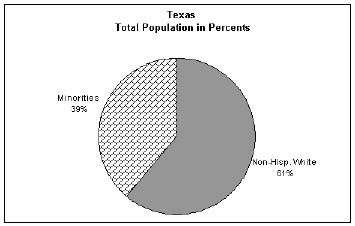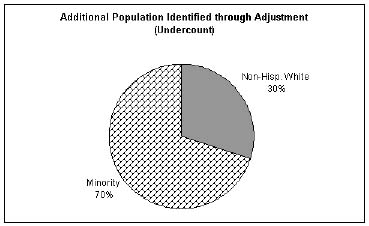State-by-State Analysis: Texas
The
1990 undercount and its demographic composition
As
indicated in Table 1, the percentage undercount of 2.8 percent in Texas
was higher than the national average of 1.6 percent and resulted in a net
numerical undercount of 486,028 persons, second highest in the nation. For
non-Hispanic whites, Table 1 indicates, the undercount percentage was only
1.4 percent as compared to 5.1 percent for members of minority groups, the
vast majority of whom were non-Hispanic blacks or Hispanics. As indicated
in Table 2 and the summary chart below, these differences between whites
and minorities resulted in an undercounted population with a much greater
minority group percentage than that of the state's total population. In
Texas, non-Hispanic whites comprised 61 percent of the state's uncorrected
population, whereas members of all minority groups combined comprised 39
percent. In contrast, non-Hispanic whites comprised 30 percent of the state's
undercounted population, whereas members of all minority groups comprised
70 percent. In numerical terms, the undercount consisted of 147,770 non-Hispanic
whites and 338,258 members of minority groups.
Although
a majority of minority group members in Texas, as in California, are Hispanic,
the minority population also includes a substantial black percentage. According
to corrected census data, non-Hispanic blacks are 29 percent of Texas's
minority population, Hispanics are 65 percent, and members of other minority
groups are 6 percent.


Implications
of 1990 Census adjustment for minority voter opportunities
The
use of corrected data in Texas for the post-1990 redistricting would have
had the potential to enhance minority voter opportunities in the plans drawn
for the State Senate and State House. In the Texas State Senate, the use
of corrected data would have enhanced minority voter opportunities by increasing
the baseline of majority-minority districts against which the next redistricting
plan will be measured. State Senate District 15, located in Harris County
(which includes the city of Houston) in the post-1990 plan, includes a minority
population of 48.9 percent. However, application of the corrected data for
1990 demonstrates that the minority population of this District is more
accurately measured at 49.8 percent, which, unlike the district as measured
with uncorrected data, can be rounded upward to 50 percent.
The
use of corrected data for Harris County also reveals a sufficient number
of additional persons, most of them members of minority groups, so that
if corrected data rather than uncorrected data had been used in the post-1990
redistricting, State Senate District 15 might have been drawn to include
a higher minority percentage than the current district, clearly putting
this district above the 50 percent mark. The corrected data in Harris County
identified an additional 98,000 persons, 77 percent of whom were members
of minority groups. This additional population was more than would have
been needed to meet one-person, one-vote requirements in this region, given
that the use of adjusted data would increase the size of an ideal State
Senate district by some 16,000 persons, from some 548,000 to 564,000.
In
the Texas State House, House District 138, also located in Harris County
in the post-1990 plan, includes a minority population of 48.6 percent. However,
application of the corrected data for 1990 demonstrates that the population
of this district is more accurately measured at 49.9 percent, which, unlike
the district as measured with uncorrected data, can be rounded upward to
50 percent. As in the State Senate, the use of corrected data in Harris
County reveals a sufficient number of additional persons, most of them minorities,
so that if corrected data rather than uncorrected data had been used in
the post-1990 redistricting, House District 138 might have been drawn to
include a higher minority percentage than the current district, putting
it clearly above the 50 percent mark.
Given
that in Texas there are 150 House districts as compared to just 31 Senate
districts, House districts are only about 20 percent as populous as Senate
districts. The ideal size of a State House district is about 113,000 persons
for uncorrected data and about 116,000 persons for corrected data, a net
increase of 3,000 persons. Thus, as compared to Senate districts, there
is a much greater opportunity to expand the minority populations of House
districts. House Districts 132 (47.2 percent minority), 134 (47.2 percent
minority), and 149 (42.7 percent minority), also in Harris County might
likewise have been drawn with an enhanced minority percentage through the
use of corrected census data. The use of corrected data would also have
presented the opportunity to enhance the minority percentage of Dallas County
House District 107 (47.6 percent minority). The corrected data in Dallas
County identified an additional 59,000 persons, 74 percent of whom were
members of minority groups. This additional population was more than would
have been needed to meet one-person, one-vote requirements in this region.





